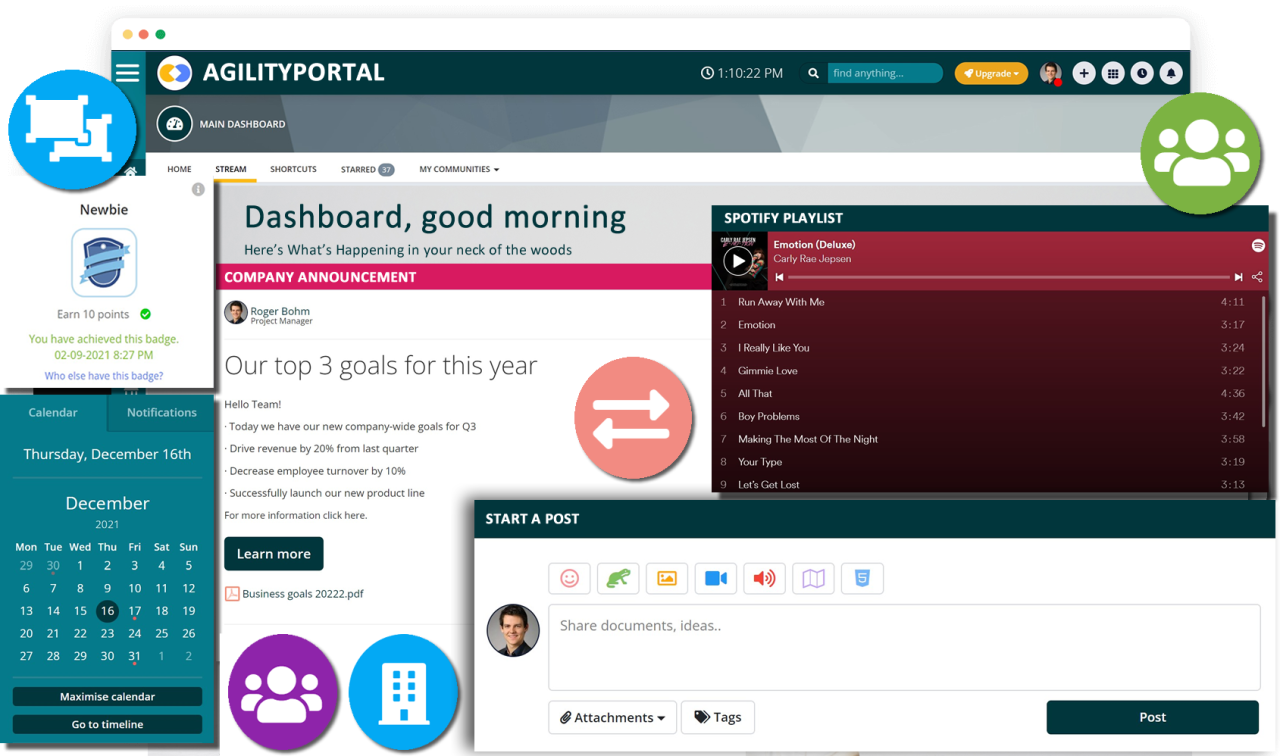Insight Blog
Agility’s perspectives on transforming the employee's experience throughout remote transformation using connected enterprise tools.
8 minutes reading time
(1549 words)
Featured
Possible reasons why you need an employee intranet for better productivity
An employee intranet helps communicate company values, goals, and important concepts and guidelines to new and existing employees, but can it actually improve productivity?
The majority of organizations nowadays are driven by data. It is critical to know information about your products, services, standard operating procedures, workflows, and much more, regardless of the size of your organization or industry. There is no silver bullet that can solve all internal communication, employee engagement, and collaboration difficulties in today's workplaces, thanks to the avalanche of information. Well, there are a plethora of internet programs that promise to give a lot. However, you require a one-stop solution that provides a wide range of business benefits while remaining within your budget and requiring a small investment.
If you're considering an intranet that's clumsy, out-of-date, and tough to use, then you need to reconsider. Workplaces have evolved significantly, as have modern intranets. These are no longer the days when an intranet gateway meant a static internal site where only a few select employees could post news, documents, and events. A site that solely allowed for one-way communication and was primarily used as an IT certified repository and news feed.
Intranets, like AgilityPortal, the best intranet software for small businesses incorporates modern-day technology, and they are highly distinct and active. Employees can stay connected, communicate, interact, access internal resources, share information, manage project assignments, and much more on an engaging platform. In a nutshell, a modern intranet remains at the heart of your workplace.
What is an employee intranet?
So what is an employee intranet, well an intranet can take the form of a website, collection of collaboration tools, or even a social network, depending on the organization. There isn't a set format. As a result, the actual concept of an intranet portal is frequently misunderstood.
An intranet is a private networks used by organizations to distribute communications that supports an organization's workforce at its most basic level. This is accomplished by making communication, cooperation, and information exchange easier. Intranets are simply one of several technologies in the digital workplace. Collaboration platforms like AgilityPortal, Slack, and Teams are among the others.
Related: Intranets VS Extranets
Intranet improve productivity
Employees in an organization may spend up to a fifth of their workday looking for information. Many of those squandered hours are spent sifting through e-mails, browsing vast file directories, or asking time-pressed coworker questions.
An intranet can save employees a lot of time by centralizing the critical information and documents that they require, such as in a central policy library or among separate communities. Employees will also be able to find what they need, thanks to a robust search engine and user-friendly navigation. Employees can also be confident that they are viewing the most recent version of a document and that there is only one source of truth, reducing search time even further.
An intranet can improve employee self-service, which refers to employees' ability to accomplish tasks without requiring assistance from another person. This method relieves a lot of strain off HR departments and other support services, and it can boost productivity by allowing these experts to focus on higher-value operations. Self-service also entails that individual employees understand how to complete tasks in the most effective manner.
When employees use intranet software, they have faster access to the information they need. This allows them to respond to problems more rapidly. They can accomplish their work more effectively because they have immediate access to the information and skills they require. Employees can also ask questions, provide feedback and insight, and assist in the resolution of other employees' concerns. This information sharing taps into an organization's collective wisdom that isn't always available in business e-mails or file cabinets. As the rate of information gathering increases, so does the rate of response.
Three reasons why some companies have intranets
Main reason for deploying an intranet within and organization:
- 1) Communicating efficiently
- 2) Collaborating effectively
- 3) Make information easy to find
- 4) Reduce risk
- 5) Cut administration costs
- 6) Share information with your entire organization, easily
- 7) Make finding documents easier
- 8) Improve collaboration and feedback
- 9) Employee satisfactions
- 10) Build a transparent culture
Using an internal social intranet for employee interaction
Collaboration improves when coworkers can communicate efficiently, but a good intranet may go even farther by allowing teams to collaborate on the same page at the same time or seeing who made what modifications before.
Your intranet will serve as the internet hub for your company. It's where people have chats, communicate corporate news, and arrange events. It's easy to see how it pulls multi-location teams together with this in mind. Regardless of where they work, every employee and location get access to information on what's going on around the company.
An intranet is a treasure trove of data. From Social Committee updates to the latest recent dental form, there's something for everyone. All of this information is useful for getting work done and staying connected to the business's softer side. Employees will be able to stay informed and get the information they require by using an intranet with a simple user interface and a powerful search feature.
Onboarding is made easier than ever before with the help of a decent intranet. With easy-to-access papers, up-to-date organization charts, comprehensive profiles of their colleagues, and a bustling news hub that provides information and insights into the company's culture, new hires may use it to get their bearings.
Intranets like AgilityPortal come with dynamic organization charts that provide clarity on your company's shape and structure. Individual bios or profiles, for example, provide rich levels to this clarity and assist employees in grasping the roles and responsibilities of individuals within your organization.
Intranets enable organic knowledge sharing to flourish as your company's person-to-person contacts grow and deepen. People can more easily connect with knowledge professionals since they are more visible. Experts can also participate in forum-style discussions or publish a blog post series to help disseminate knowledge within the organization. As a result, the company's knowledge can rapidly increase as a large number of people contribute their own learnings.
If your inbox is overflowing with e-mails and your calendar is overflowing with meetings, it's time to invest in an intranet. Intranets with a good, integrated chat feature make it simple to have conversations. You'll be able to avoid the dreaded reply-all e-mail and instead conduct constructive conversations away from your cluttered inbox.
It's easier to keep everyone informed and get feedback with better internal communication. As a result, you won't require as many large group meetings that eat into many calendars' time.
Disadvantages of using intranet
An intranet is a network that allows enterprises to interact, share information, and carry out critical operational functions. There is one restriction, however: it is not available to outsiders and can only be used by employees of the company. An intranet software's primary goal is to link employees inside the corporation.
That means engaging with team members on work-related tasks, providing easy access to team documents and workspaces, and keeping all team members connected to key business information at all times for modern firms that embrace remote and flexible work. Employees can use intranets to collaborate on projects, comment on new initiatives, store goals, and communicate across the firm.
One of the most significant drawbacks is the threat to the company information resource's security. The intranet puts the corporate information resource at risk of losing its privacy and possibly being altered without permission. Intranet technology is still quite vulnerable, and the danger of information security and privacy on the intranet is greater.
The organization faces another problem with the intranet, which is the necessity to modify the work culture in order for the intranet to be effective. Executives, particularly those at the top of the managerial hierarchy, have a habit of delegating information handling, including mail, to their secretaries.
E-mails are frequently printed out by secretaries and dropped on the executive's table by the secretary. In the event of an overly ambitious or disgruntled secretary, the practice of sharing passwords with secretaries might be disastrous for the executive and the company. Another cultural shift that is required is in response time.
Because intranet communications are more convenient and less expensive, the volume of e-mails/questions is likely to rise, and if they are not responded to promptly, they will pile up, causing havoc in the organization. One more concern that is being discussed these days is the risk of less face-to-face interaction between employees, which could lead to alienation in the company. However, no such evidence has been found in research.
Conclusion
Intranets can assist ensure that information is available to decision-makers without their having to ask for it. Large amounts of data can be sent from far-flung sites without incurring high connectivity costs. Intranet encourages members of the workgroup to share knowledge as a habit. In addition to e-mail among workgroup members, intranets typically feature facilities for electronic meetings and group decision support systems.
Categories
Blog
(2572)
Business Management
(315)
Employee Engagement
(204)
Digital Transformation
(171)
Intranets
(119)
Growth
(115)
Remote Work
(61)
Sales
(48)
Collaboration
(37)
Culture
(29)
Project management
(29)
Customer Experience
(25)
Knowledge Management
(21)
Leadership
(20)
Comparisons
(5)
Ready to learn more? 👍
One platform to optimize, manage and track all of your teams. Your new digital workplace is a click away. 🚀
Free for 14 days, no credit card required.

















